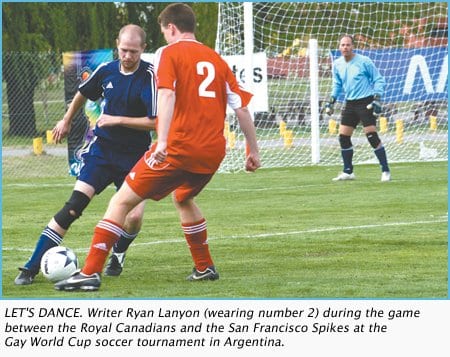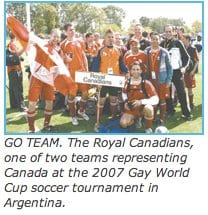***
It’s not every sporting event that starts with you and your teammates chanting and dancing along with a Madonna megahit but that’s exactly how things got underway at the opening ceremony at this year’s Gay World Cup in Buenos Aires, Argentina.
For the first time in its history the International Gay and Lesbian Football Association held its annual world championship soccer tournament in macho soccer-crazy South America. Teams representing major cities in the UK, US and Australia, along with teams representing Iceland and Europe all came to battle it out with teams from Mexico, Chile, Uruguay and host nation Argentina.
Canada sent two teams to the World Cup — the Toronto Titans and the Royal Canadians. The Titans is a club team that has played together for the last 18 months and won bronze at the Chicago Gay Games last year, while the Royals was a team formed just for the tournament.
I was never very good at soccer as a kid (I stopped playing after scoring on my own team) so I found myself playing with the Royal Canadians. We were a hodge-podge of Torontonians joined by some honorary Canucks from Texas, Boston and Italy who needed a team to play with. We met them for the first time on the field, united in the common desire to have some fun kicking a ball around in Argentina.
Fun found us before we ever hit the field. The night before the games began most of our team headed to Amerika, a hot bar in Buenos Aires where the tournament’s kick-off party was held. The event began with the usual greetings and speeches, in both Spanish and English, and was accompanied by a local drag queen who had been stuffed ever so tightly into a blue-and-white striped Argentine soccer jersey.
Following the drag show visiting teams were treated to another display of local culture, the tango. But not just any tango. This one began with two men, and then introduced a third female performer. I stepped away to the open bar and when I returned the tango dancers had been replaced by a muscular, hot Latino stripper sporting a full erection on stage. Gotta love that local culture. We made certain to take pictures.
The next day our team faced a gruelling schedule: Recover from various states of hangover and play three games of soccer, not necessarily in that order. Taking up the challenge we donned our fashionable red-and-white uniforms and hit the pitch.
Competitive gay soccer isn’t much different than what’s played in straight leagues. There’s the usual pushing, shoving, mandatory bruising and theatrics in the hopes of getting penalties against the opposing team, but with a few more winks and apologies. What does make gay soccer different is the encouragement between players of all skill levels, the camaraderie after the games and of course the shameless flirting both on and off the field. Sometimes if you can’t get a goal in a game, there are other ways to score.
Tournament organizers gave us plenty of opportunities to flirt with a full schedule of late-night parties (local bars don’t even open until 2am). Buenos Aires is a city renowned for its clubs and parties, but much to my surprise the locals are incredibly accepting of queers. Couples openly showed affection at the soccer fields, on the subway and even on the street, while the porteños (citizens) barely even noticed.
Those who did notice, however, were the media. Wear something flamboyant at the soccer field? Your picture was taken. Show some gay pride? Next thing you know you’re saying hello to Venezuela through the lens of a video camera.
With all the attention, acceptance and amazing clubs Buenos Aires felt truly gay fabulous. Like back in the 1990s before gay marriage, Queer as Folk and the internet made being gay a rather ordinary thing in Toronto.
Back on the field it wasn’t until our third day of play that all our energy translated into some results for the Royal Canadians. We lost all four of our qualifying games without even scoring a goal. But by the time the playoffs came around we managed to hold off the London Leftfooters to a zero-zero tie. Since only one of the teams could advance to the next round we went to shootouts to determine the winner. By a stroke of luck one ball bounced from the goalpost into the net and we won our first game and continued on.
The next game was won handily by our opponents, the Philadelphia Falcons, but we still had one hope left — a wildcard spot in the semifinals. It meant we had to win another shootout, this time against both Chile and Europe. The team from Europe was eliminated first, leaving us to battle it out with Chile.
The Chileans were up first; they scored on all three shots. Now it was our turn, and I was the first one up. If I didn’t score, Chile would automatically win and we would stop at fifth place of the second division. I jogged up to the ball and kept thinking two things: Get some power on the ball and kick it low to the side. I couldn’t bear to look at the other players from the Toronto teams who were all watching.
It felt like the field went silent and then I kicked. It went pretty hard but time seemed to slow as it approached the net on the left side… and then passed it. I missed. I could hear the cheers in Spanish from the Chilean players in the background.
I held my head down and walked back to my team where they greeted me warmly and showed me all the support I’ve come to expect of Toronto’s gay soccer leagues. In fact, much to my amazement, they started to hug and thank me. You see, for the Royal Canadians the tournament was now over and we would finally have some free time to partake in that other favourite pastime of the porteños and my teammates — shopping.
I love gay soccer.


 Why you can trust Xtra
Why you can trust Xtra


